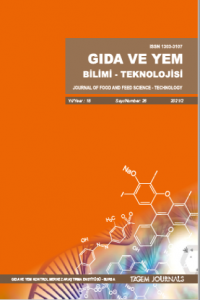BALIK YAĞI GIDA TAKVİYELERİNDE METAL BULAŞANLARININ (As, Hg, Cd, Pb) BELİRLENMESİNDE ANALİTİK PARAMETRELERİN OPTİMİZASYONU
Balık yağı, mikrodalga ısıtmalı çözünürleştirme, merkezi kompozit dizayn, ICP-MS
OPTIMIZATION OF ANALYTICAL PARAMETERS FOR DETERMINATION OF (As, Hg, Cd and Pb) IN FISH OIL SUPPLEMENTS
___
- Anonymous, 2010. Gıda Tarım ve Hayvancılık Bakanlığı Veteriner Hizmetleri, Bitki Sağlığı, Gıda ve Yem
- Kanunu. http://www.resmigazete.gov.tr/eskiler/2010/20100613-12.htm- (Erişim tarihi: 04.02.2013).
- Baer, I., Emteborg, H., Calle, B.2011. Results from two interlaboratory comparisons on the measurement of
- trace element contents in food supplements – State of the art of control laboratories in Europe. Food Chemistry,
- :1498–1504.
- Breemen, R. B., Fong, H. S., Farnsworth, N. R., 2007. The Role of Quality Assurance and Standardization
- in the Safety of Botanical Dietary Supplements. Chem. Res. Toxicol. 20:577-582.
- Dietz, B., Bolton, J. L., (2007). Botanical Dietary Supplements Gone Bad. Chem. Res. Toxicol,
- : 586-590.
- Garcia-Rico, L., Leyva-Perez, J., Jara-Marini, M. E., (2007). Content and daily intake of copper, zinc, lead,
- cadmium, and mercury from dietary supplements in Mexico. Food and Chemical Toxicology, 45:1599–1605.
- Ho, C. T., Simon J. E., Shahidi F., Shao, Y. 2008. Dietary Supplements: An Overview. ACS Symposium
- Series; American Chemical Society: Washington, DC.
- Kohlmeyer, U., Jakubik, S., Kuballa, J., Jantzen, E. 2005. Determination of Arsenic Species in Fish Oil
- After Acid Digestion. Microchim Acta, 151:249–255.
- Kowalewska, Z., İzgi, B., Saraçoğlu, Ş., Güçer, Ş. 2005. Application of Liquid-Liquid Extraction and Adsorption
- on Activated Carbon to the Determination of Different Forms of Metals Present in Edible Oils. Chem.
- Anal., 50:1007-1019.
- Mester, Z., Sturgeon, R., (2003). Sample Preparation For Trace Element Analysis. Elsevier, Canada, 1339s.
- Mol, S., (2008). Balık Yağı Tüketimi ve İnsan sağlığı Üzerine Etkileri. Journal of Fisheries Sciences,
- (4): 601-607.
- Petroczi, A., Taylor, G., Naughton, D. P., (2011). Mission impossible? Regulatory and enforcement issues
- to ensure safety of dietary supplements. Food and Chemical Toxicology, 49,393–402.
- Raman, P., Patino, L., Nair, M. 2004. Evaluation of Metal and Microbial Contamination in Botanical Supplements.
- J. Agric. Food Chem., 52: 7822-7827.
- Usydus, Z., Szlinder-Richert, J., Polak-Juszczak L., Malesa-Ciec´wierz M., Dobrzan´ ski, Z., (2009). Study
- on the raw fish oil purification from PCDD/F and dl-PCB-industrial tests. Chemosphere, 74:1495–1501.
- ISSN: 1303-3107
- Yayın Aralığı: Yılda 2 Sayı
- Başlangıç: 2015
- Yayıncı: Bursa Gıda ve Yem Kontrol Merkez Araştırma Enstitüsü
TÜRKİYE’DE YETİŞEN YABAN MERSİNİ MEYVESİNİN FENOLİK BİLEŞİKLERİNİN KARAKTERİZASYONU
Semanur YILDIZ, Hakan YAVAŞ, Ozan GÜRBÜZ, Nurcan DEĞİRMENCİOĞLU
GIDA İLE TEMAS EDEN MADDE VE MALZEMELERDEN GIDAYA GEÇEBİLECEK ALÜMİNYUM MİKTARI VE BUNUN RİSKLERİ
Gülnur BİRİCİK, Nazan ÇÖPLÜ, Adnan DAĞDELEN
DUMANLANMIŞ SU ÜRÜNLERİ VE POLİSİKLİK AROMATİK HİDROKARBONLAR (PAH's)
TARIMDA VE GIDADA NANOTEKNOLOJİ
